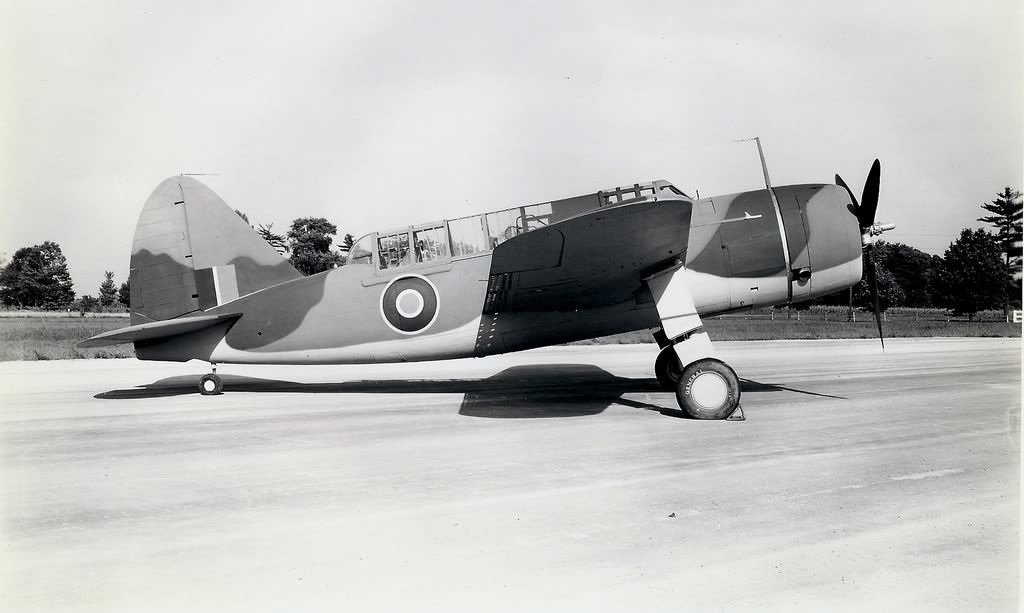
ADF-SERIALS
Australian
& New Zealand Military Aircraft Serials & History
RAAF Brewster Bermuda

Following the completion of the F2A production run, the Brewster Aeronautical Corporation's difficulties went from bad to worse. The corporation had received large orders for its Model 340 Dive bomber, which was a scaled-up version of the SBA with a 1700 hp Wright Cyclone R-2600 twin-row air-cooled radial.
History
The British Purchasing Commission ordered 750 examples of the Model 340 in July of 1940 as the Bermuda, and the Dutch government ordered 162 similar examples for the Netherlands East Indies. On December 24, 1940, the US Navy ordered 140 (later increased to 203) examples as the SB2A Buccaneer.
Throughout 1941 and 1942 handling and production problems caused lengthy delays, and the USN had decided that there was no need for a new dive-bomber when the SB2A finally became available. Deliveries were halted after only two SB2A-1’s. The Curtiss Helldiver would fulfill their requirement of both a land based and carrier based Dive-bomber.
The A-34 USAAF designation was assigned for contractual purposes to the Lend-Lease version of the Brewster SB2A-2 intended for delivery to Great Britain. The SB2A-2 and Model B-340E (export version, Serials FF 419 to FF 868) "Bermuda" were modified for land use and much of the equipment for operating from an aircraft carrier removed - folding wings, arrestor hook and catapult gear. The rear turret of the Navy version was replaced with a flexible machine gun mount for the rear gunner. The Brewster SB2A dive-bombers the KNIL ordered had been built, but in event, the Japanese occupation of the Netherlands East Indies overtook the deliveries of the aircraft.
All 162 NEIAF aircraft were taken over by the US Marine Corps and were marked as SB2A-4's. These aircraft had cockpits still label in Dutch. Those Bermudas built were eventually used as target tugs, while others were scrapped straight from the production line. At the conclusion of production, a total of 1052 Brewster Bermudas had been built.
RAAF
In the RAAF context, desperately short of modern types in 1941, some 243 Brewster Bermudas were to be initially ordered to equip several squadrons.
It was expected that the
initial four would arrive during June 1941 and with subsequent monthly
deliveries would allow the following 11 squadrons to equip with 18
Bermudas each (12 IE & 6 IR):
•
Establishing 27 Squadron RAAF
July 1941 Hobart, Tasmania.
•
Re-equipping 21 Squadron RAAF August 1941
Malaya from Wirraways.
•
Establishing 28, 30 and 31
Squadrons RAAF at Richmond, NSW September 1941.
•
Establishing 26 Squadron RAAF
and re-equipping 12 Squadron RAAF from Wirraways at Darwin, NT during
October 1941.
•
Re-equipping 22 and 25
Squadrons RAAF in each capital City during November 1941 from Wirraways.
•
Re-equipping 4 Squadron RAAF
Canberra during December 1941 from Wirraways.
•
Re-equipping 5 Squadron RAAF
with ex-30 Sqn Bermudas during January 1942 from Wirraways.
•
Re-equipping 23 and 24
Squadrons RAAF in each capital City during February (with Ex-31 Squadron Bermudas) and
March 1942 respectively from Wirraways.
• This would leave a pool of 45 aircraft for maintenance, training and normal attrition.
For 30 and 31 Squadrons RAAF (based at Richmond, NSW) the plan was to only use the Bermudas as transition trainers until they were re-equipped with twin-engine fighters allocated from some 54 Beaufighters ordered during May 1941. With 12 to arrive December 1941, followed by 14 monthly by March 1942, thereby making a total of 54 Beaufighters.
Due to the lengthy delays, apparent un-resolved design and performance flaws with the Bermuda aircraft, the RAAF during November 1941, decided to cancel and place orders for the Vultee Vengeance dive-bombers instead.
Brewster Aeronautical Corporation, following all of these problems, was taken over by the US Navy on 18th April 1942, with Captain G C Westervelt of the Navy Construction Corps (Ret) placed in charge of the company. A month later the Navy turned over the corporation to a new board of directors, with Charles Van Dusen as the president went on to licence produce Vought Corsairs, under the designation of F3A-1’s from 1943 onwards.
The first F3A-1 did not fly until April 26, 1943 and by the end of 1943 only 136 had left the production line. The delays in the F3A program were the source of several Congressional hearings. Because of the controversy, the Navy terminated Brewster's F3A contract on July 1, 1944 after 738 had been built. Brewster then went out of the aircraft business shortly thereafter.
Meanwhile, though not all of the quoted Squadrons formed, 30 and 31 Squadrons RAAF still received their Beaufighters as their first equipment some months later in April 1942. But by then, the Pacific war had started and the RAAF was still waiting for the delivery of Vultee Vengeances.
